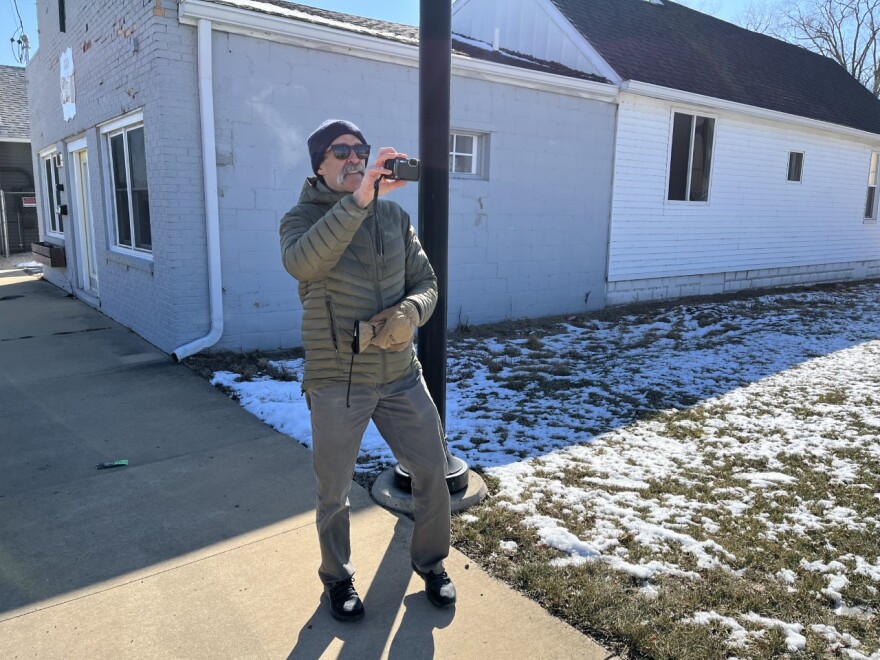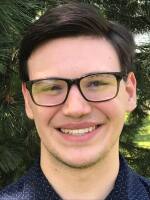Public and private community leaders across Greater Peoria are thinking critically about the way we get around.
A coalition of groups called Active People, Healthy Illinois (including the Peoria City/County Health Department, the Peoria YMCA and the Tri-County Urban Planning Commission, among others) invited transportation and public health consultant Mark Fenton to East Peoria for a “walk audit” with community leaders earlier this month.
The day before the workshop, WCBU followed Fenton along a snowy sidewalk in a small residential neighborhood just outside of East Peoria's Levee District on a chilly, windy morning. The next day, Fenton will take a group of Greater Peoria leaders and organizations on the same circuit: past Clock Tower plaza, underneath the Cedar Street bridge, through surrounding homes, and back to the lights of the Levee district.
The sidewalk seems to disappear as we approach chain link fences and a wide open field. But Fenton points out a worn path through the field, showing footprints and the indentation of bicycle tires. This isn't a private path. This is public, if a little hidden, and there are people who depend on it, for work, shopping and more.
“This is their only choice,” said Fenton. “And we can do better.”

This is just one example of the kind of discovery Fenton hopes to promote with his "walk audits". Inviting people to spend a moment moving through the world and identifying problems in a way they normally wouldn't.
“The design here, you’ll notice, the yield line is up there, about one car length back from the pedestrian crossing,” Fenton says as we wait to cross a roundabout. “So we’re kind of protected, if a car slows down to yield there, we’re back a good deal from that.”
Later, Fenton stops to take a picture of a crosswalk without a signal, just two lines on a busy street.
“Pedestrians will think: ‘oh, I’m protected, there’s a crosswalk’ and cross there, right?” he says. “But, in fact, there’s not enough protection, it’s pretty dangerous. It’s an uncontrolled intersection. Those cars are all looking ahead to this stoplight, they’re not looking for a pedestrian there. That’s the wrong solution.” Instead of just talking at the participants on Fenton's walks, he's hoping to lead them to these discoveries themselves, taking time to consider every aspect of the experience.
“Feel the experience that others have all the time,” he said. “There are folks who live in that community and work in these stores who deal with this all the time.”

Dr. Leslie McKnight, director of Community Health Policy and Planning for the Peoria City/County Health Department, says the issues identified by Fenton's walks play into the broader topic of transportation equity, or access for all. She says communities across the country are asking more questions about their transportation infrastructure, after decades of urban design with cars as a priority.
“It’s getting vehicles through communities or through thoroughfares as quickly and as fastly as they can,” she said. “Oftentimes, with that perspective, there’s not the considerations for…those that may have other mobility options. Whether they’re walking or biking.”
But McKnight and Fenton agree, the conversation is starting to change. It certainly isn't the first time Americans have examined our relationship to cars, but Fenton points to the Coronavirus pandemic as a catalyst.
“A lot of communities were setting out street side seating for restaurants and cafes,” he says. “We were widening sidewalks, sometimes even with things like cones and paint and tape, so we had places for people to walk safely at safe social distance and bicycle. Because we were driving less, we were reallocating street space for social engagement.”
McKnight says experiences like these, that demonstrate the way the space used by streets and cars could be repurposed for social activities or equity reasons, lead residents to ask a difficult question: what exactly do we want out of our communities?
“Do we want a community where our goal is to get as quickly as possible to where we need to go?” said McKnight. “And wherever we need to go, the only way to get there is by vehicle?”
Or, McKnight asks, do we want to be able to decide to take the bus, a stroll, or bike to work on a whim? There are also other considerations.
“Or if I have a family member who has a disability, or may be in a wheelchair, that we can walk or they can get to where they go independently?” she said. “You have to really start intentionally thinking about that and saying: is that the kind of community that I want to be in?”
It's also not just about accessibility for those with health issues or disabilities. There's also the health of the general public. As McKnight and Fenton point out: communities where more people can walk or bike as part of a routine are healthier communities.
“The Surgeon General told us way back in 1996 that everybody should try to average about 30 minutes of physical activity a day,” said Fenton. “That it will reduce the list of cardiovascular disease, type 2 diabetes, osteoporosis, clinical depression, dementia in old age and a growing list of cancers.”
Now, none of this is to say Greater Peoria doesn't already have some options for public transportation. If you visit CityLink's downtown Peoria bus depot on any given afternoon, you can meet people like Johnny Thomas, who says he depends on the bus around five times a week.
“To get to my doctor's appointment, to get to Walmart,” he says. “To get to church, things of that nature.”
Thomas says CityLink is dependable, even compared to the public transportation systems in larger cities. For him it's also economic.
“I like the fact that you can buy a bus pass for three dollars and get around all day long,” he said. “You go to Chicago, you’re paying over four dollars per bus ride. So the price here with the size of the city is just absolutely solid.”
For others, like Mac Talley, who has been relying on the buses for around six years, there are some concerns, like showing up early.
“When they show up early, some people are going to miss the bus,” he said. “Then they end up late for work.”
But, overall, Talley says it's not difficult to depend on CityLink for getting around Peoria.
Fenton and McKnight say there are active efforts to improve public transportation and infrastructure in our area. This is partially due to high availability of state and federal infrastructure funding, the Biden Administration's infrastructure investments and the Rebuild Illinois initiative chiefly among them.

Doug Roelfs, General Manager of CityLink, says a state grant made their recent renewal of a pilot route in Washington possible. They've also received more than five million from Rebuild Illinois, which they're putting towards expanding their electric bus fleet.
“We’ll probably have to improve some of our charging infrastructure,” he said. “I think with this round, we’ll probably get at least four buses added to the fleet.”
This doesn't only mean a wider, more reliable fleet. It also means quieter rides, lowered emissions and future proofs CityLink's buses for an ongoing transition to cleaner energy.
There's also the larger scale, community wide projects. Fenton points to the addition of a pedestrian and bike path to the Bob Michel Bridge as an example.
“But what about when I don’t have $250 million or whatever for a huge project,” he said. “The reality is there are lots of tools that are much less expensive. In fact the most important tool is what I would call routine accommodation.”
Routine accommodation simply means considering everyone who uses the street: cars, bikes and pedestrians, every time changes are made. McKnight says the City of Peoria passed a "complete streets" policy that includes this in 2015.
“But, as we know, that is the first step,” she said. “You have the policy, but the policy is just the framework for implementation.”
Implementation happening in the infrastructure projects dotting Peoria’s roads now.
Philip Behr is the Director of Community Outreach at OSF Saint Francis Medical Center. He participated in the walk audit with Fenton. After the experience, he says his mind was buzzing with his own, smaller ideas for OSF's work in the 61605 zip code.
“There’s not a lot of close grocery stories, what would it look like in the future if we had a new grocery store in that area?” Behr said. “How would individuals get to that grocery store? Or how would they access their healthcare or their physician’s office?”
Behr says one of the most effective parts of the walk audit was when Fenton invited participants to think about their childhoods: walking to school, biking all night or spending a day without parents at the park.
“It makes a lot of sense in terms of: how can we work towards getting a portion of that back?” he said. “Or at least creating a safe environment for our kids to either bike to or play at.”
Questions like these are exactly in line with the ones Fenton hopes to generate with walk audits. He says he sees "enthusiasm and energy" for positive change in the Greater Peoria area.
“I see a real awareness of hope in a positive future,” Fenton said. “Because of the energy of folks and the breadth of people that are engaged on this topic.”
Now, Peoria's transportation future is up to leaders, the available funding, and ultimately how much the community desires getting out on their bikes or strolling to work on a sidewalk again.


